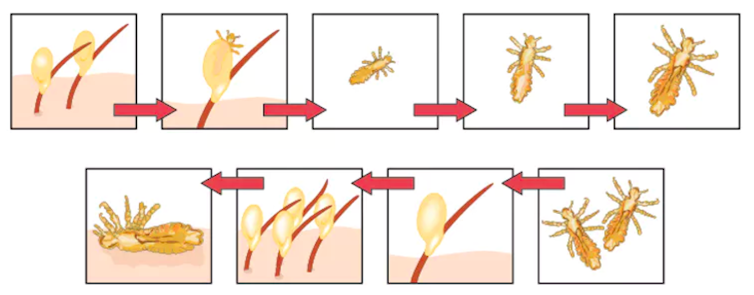Back at school? Here is how to keep kids free of head lice

A new school year, and another battle between bloodsucking parasites and the kids they love to live on.
But the real casualties are the stressed-out parents and carers trying to keep their kids free of lice.
Here are some tips for delaying the inevitably tricky task of lice treatment for as long as possible.
Remind me, what are head lice?
Head lice (Pediculus capitis) are insects found almost exclusively in the hair on human heads. These parasites aren’t found anywhere else on the planet.
They’re perfectly designed to scuttle up and down strands of hair, feeding on blood from the scalp of those infested. They typically feed about three times a day, spending up to 15 minutes on each occasion.
While their bites may cause some mild irritation, lice don’t spread bugs that make us sick.
Head lice don’t live long – not much more than a month. The adults lay eggs (commonly known as nits), which typically hatch in around a week or so. This life cycle is simple, but crucial for identifying and eradicating infestations.

You want to remove the adult lice, then treat again two weeks later to get rid of the newly hatched lice before they have a chance to lay more eggs. By Blamb/Shutterstock
It’s worth investing in a lice comb.
The eggs are immovably cemented to shafts of hair. These eggs, even when the lice have hatched, will remain and grow out with the hair strands.
This means that spotting nits more than a centimetre or so from the scalp may not require treatment at all.
Instead, look for the live lice moving about. This is the most reliable way to confirm an infestation. Use a special lice comb from the local pharmacy to make the search easier.
How do children become infested?
Head lice don’t jump or fly or swim. They move from head to head through direct contact as the strands of hair from two people make contact, creating a bridge for adventurous lice to a new world.
But lice can be fussy, with one study showing hairs need to be specifically aligned to allow the parasites to skip from one strand to another.
This is why transmission of lice from one person to another doesn’t happen as readily as urban myths suggest.
Sharing hats, towels, or pillows won’t dramatically increase the chance of picking up head lice. They’re not going to crawl across the classroom floor either.
Direct head-to-head contact is the best way to share an infestation, so keep an eye out for kids crowded around smartphones and tablets!
Lice don’t necessarily have a particular predilection for clean or dirty hair. Short hair isn’t immune from infestation, but long hair means the chances of picking up lice are greater.
Ensuring hair is neatly pulled back will dramatically reduce the risk of picking up head lice.
Are head lice really a problem in Australia?
Head lice are a problem the world over. But they are more of a nuisance than a health risk in most instances.
Research suggests around one-third of Australian primary school-aged children could currently have head lice. With more than 2.1 million primary school students in Australia, that’s about 700,000 potentially infested children.
The thought of head lice may be actually worse than the itchiness resulting from an actual infestation. The Australian Academy of Science provides an entertaining breakdown of why this maligned parasites cause so much stress.
It’s more difficult to control head lice than in the past. International studies indicate lice are becoming resistant to commonly used insecticide treatments. This is also likely to be a problem in Australia but more research is needed to better understand the situation here.
Alternatives to traditional insecticides, such as botanical extracts, may be more useful in the future.
Most health authorities in Australia recommend avoiding insecticides, and instead suggest wetting the hair (or using conditioner) and then combing the lice out.
Essential to eradicating head lice infestations is two treatments, each about a week apart. This ensures adult lice are killed, then any eggs remaining are allowed to hatch but those newly hatched lice are killed by the second treatment before they have an opportunity to lay more eggs.
I’m itchy already!
Perhaps the biggest health issue associated with head lice is the stress and anxiety for parents and carers of infested children.
Even before a single louse is even spotted, finding a note from the school warning of a “lice outbreak” could be enough to trigger frantic head scratching! There is even a term for this: psychosomatic itching.
Unfortunately, there are no quick fixes for getting rid of lice. And no matter what social media claims, using mayonnaise, hair straighteners or household cleaning products) is a bad idea.
The most important thing to remember is lice aren’t going to cause health problems, nor are they indicators of poor household hygiene or quality of care.
This article was first published on The Conversation and written by Dr Cameron Webb.

